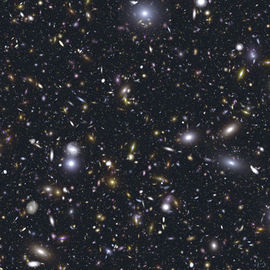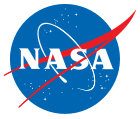James Webb Space Telescope
 Artist's impression of JWST. In normal working mode the mirror will not be lit, as it will be in complete and permanent sun-shade from the radiation shield below. |
|
| General information | |
|---|---|
| Organization | NASA / ESA / CSA |
| Major contractors | Northrop Grumman Ball Aerospace |
| Launch date | 2014[1] or in 2015[2] |
| Launched from | Guiana Space Centre ELA-3 Kourou, French Guiana |
| Launch vehicle | Ariane 5 |
| Mission length | 5 years (design) 10 years (goal) |
| Mass | 6,200 kg (14,000 lb) |
| Orbit period | 1 year |
| Location | 1.5×106 km (Lagrangian point L2) |
| Telescope style | Three Mirror Anastigmat |
| Wavelength | 0.6 to 28 µm (infrared) |
| Diameter | ~6.5 m (21 ft) |
| Collecting area | 25 m2 (270 sq ft) |
| Focal length | 131.4 m (431 ft) |
| Instruments | |
| NIRCam | Near IR Camera |
| NIRSpec | Near IR Spectrograph |
| MIRI | Mid IR Instrument |
| FGS | Fine Guidance Sensor |
| Website | www.jwst.nasa.gov |
The James Webb Space Telescope (JWST) is a planned infrared space observatory and is the scientific successor to the Hubble Space Telescope. The JWST or Webb Telescope's main scientific goal is to observe the most distant objects in the universe beyond the reach of either ground based instruments or the Hubble. The JWST is a project of the United States space agency (NASA) with international collaboration from the European Space Agency and the Canadian Space Agency, including contributions from fifteen nations.
Originally called the Next Generation Space Telescope (NGST), it was renamed in 2002 after NASA's second administrator James E. Webb (1906–1992). Webb had headed NASA from the beginning of the Kennedy administration through the Johnson administration (1961–68), thus overseeing all the manned launches in the Mercury through Gemini programs, until just before the first manned Apollo flight.
Current plans call for the telescope to be launched on an Ariane 5 rocket in June 2014 (or mid 2015) on a five-year mission (10 year goal).[3] The JWST will orbit the Sun in Earth's partial shadow [4], approximately 1,500,000 km (930,000 mi) on the far side of Earth at the L2 Lagrange point. Objects at the L2 point orbit the Sun in synchrony with the Earth, which allows JWST to use one radiation shield, positioned between the telescope and the Earth, to protect it from both the Sun's and the Earth's heat and light. It's also possible for the same shield to block moonlight, because the telescope is much further from Earth than the Moon is.
Contents |
Mission
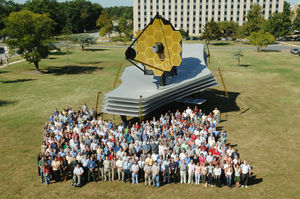
The JWST's primary scientific mission has four main components: to search for light from the first stars and galaxies which formed in the Universe after the Big Bang, to study the formation and evolution of galaxies, to understand the formation of stars and planetary systems and to study planetary systems and the origins of life.[5] All of these jobs are more effectively done in the near-infrared than the visible. For this reason the JWST will lose the Hubble Telescope's visible light and ultraviolet capability but will be able to see much further into the infrared.
Due to a combination of redshift, dust obscuration, and the low temperatures of many of the sources to be studied, the JWST must operate at infrared wavelengths to see deeply into dust or distance. Its present design spans the wavelength range from 0.6 (near the cutoff between red and near-infrared) to 28 micrometers (deep infrared which corresponds to temperatures of about 100 kelvins). To ensure that the observations are not hampered by infrared emission from the telescope and instruments themselves the entire observatory must be cold. It must be well-shielded from the Sun so that it can radiatively cool to roughly 40 K (−230 °C, −390 °F). To do this JWST will incorporate a large metalized fan-fold sunshield which will unfurl to block infrared radiation from the Sun, Earth and Moon. The telescope's location at the Sun-Earth L2 Lagrange point ensures that the Earth and Sun occupy roughly the same relative position in the telescope's view and thus make the operation of this shield possible.[6]
The observatory is due to be launched no earlier than June 2014 and is currently scheduled to be launched by an Ariane 5 from Guiana Space Centre Kourou, French Guiana into an L2 orbit with a launch mass of approximately 6.2 tons. After a commissioning period of approximately six months the observatory will begin the science mission which is expected to last a minimum of five years. The potential for extension of the science mission beyond this period exists and the observatory is being designed accordingly.[7]
Orbit

To avoid swamping the faint astronomical signals with radiation from the telescope, the telescope and its instruments must be very cold. JWST has a large shield that blocks the light from the Sun, Earth, and Moon, which otherwise would heat the telescope and interfere with the observations. To have such a shield work, JWST must be in an orbit where all three of these objects are in about the same direction. The answer was to put JWST in an (relatively small) orbit around the Earth-Sun L2 point, or L2. At the L2 point, the Sun and Earth are in exactly the same direction at all times, and the moon swings laterally in orbit by only a relatively small amount.
The telescope's L2 orbit will be an elliptical orbit about the semi-stable second Lagrange point. The Earth-Sun L2 point, about which the Webb telescope will orbit, is 1,500,000 km (930,000 mi) from the Earth, which is about 3.92 times farther away from Earth than is the moon. (This distance underscores how much more difficult the Webb telescope would be to service than the Hubble telescope after launch; no plan contemplates doing so). The large distance of L2 from Earth compared with the distance of the moon from the Earth, means that the diameter of the moon's orbit is less than 30 degrees as seen from the view of JWST. This allows the telescope's radiation shield (which is not symmetrical) to block all moonlight from the telescope, even as the moon moves to the extremes of its orbital excursion away from the Sun-Earth line. The shield extends farther laterally on one axis for this reason.
Normally, an object circling the Sun further out than the Earth would take more than one year to complete its orbit. However, the balance of gravitational pull at the L2 point (in particular, the extra pull from Earth as well as the Sun) means that JWST will keep up with the Earth as it goes around the Sun. The combined gravitational forces of the Sun and the Earth can hold a spacecraft at this point, so that in theory it takes no rocket thrust to keep a spacecraft in orbit around L2. In reality, the stable point is comparable to that of a ball balanced upon a saddle shape. Along one direction any perturbation will drive the ball toward the stable point, while in the crossing direction the ball, if disturbed, will fall away from the stable point. Thus some station-keeping is required but with little energy expended.
Optics
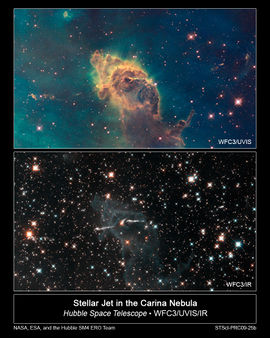
Infrared reveals more stars
JWST is a true successor to the Hubble Space Telescope (HST), because JWST will be able to see many more and much older stars.[8] Compare the two images taken utilizing the HST of the Carina Nebula. Though both images are of the same astronomical object taken by HST, the top image was photographed utilizing the visible spectrum, whereas the bottom image was taken in the infrared. Notice how more stars can be counted almost anywhere in the bottom (infrared spectrum) image than in the same corresponding location of the top (visible spectrum) image.
Visible spectrum views cannot peer through much of the gas and dust that may obscure an image like infrared views can. Almost all of the gas and dust obscuring images in visible spectrum views may entirely disappear if viewed in the infrared, so that the stars lying behind the gas and dust become easier to see.[9] Infrared astronomy can penetrate dusty regions of space (such as molecular clouds), detect objects such as planets, and also view highly red-shifted objects from the early days of the universe.[9]
The most distant stars in view are also the "youngest," that is, they were formed during a time period closer in time to that of the Big Bang[10] than those stars less distant to us, such as our Sun. Because the universe is expanding, the light reaching us from those younger stars becomes red-shifted and are therefore easier to see if viewed in the infrared.[9]
Infrared light is also useful for observing the cores of active galaxies which are often cloaked in gas and dust.[9]
JWST optical design
Although JWST has a planned mass half that of the Hubble, its primary mirror (a 6.5 meter diameter gold-coated beryllium reflector) has a collecting area which is almost six times larger. As this diameter is much larger than any current launch vehicle, the mirror is composed of 18 hexagonal segments, which will unfold after the telescope is launched. These mirrors are currently being developed by Axsys Technologies in Cullman, Alabama. Sensitive micromotors and a wavefront sensor will position the mirror segments in the correct location, but subsequent to this initial configuration they will only rarely be moved. This process is much like an initial calibration, unlike terrestrial telescopes like the Keck which continually adjust their mirror segments using active optics to overcome the effects of gravitational and wind loading.
Ball Aerospace & Technologies Corp. is the principal optical subcontractor for the JWST program, led by prime contractor Northrop Grumman Aerospace Systems, under a contract from the NASA Goddard Space Flight Center, in Greenbelt, Maryland.[11] Seventeen additional primary mirror segments, secondary, and tertiary mirrors, plus flight spares, will be delivered to Ball Aerospace from its beryllium mirror manufacturing team that includes Axsys, Brush Wellman, and Tinsley Laboratories. As each additional mirror is delivered to Ball Aerospace over the next year (to 2010), it will be mounted onto a lightweight, actuated strong-back assembly and undergo functional and environmental testing.
NASA has indicated that they will be incorporating microshutters, each about 100 by 200 micrometers, into the optics of the James Webb Space Telescope's Near InfraRed Spectrograph. An array of 62,000 of the shutters will sit in front of the spectrograph's 8-megapixel infrared detector. The microshutters will create an effect similar to a human eye squinting. When one squints, one's eyelashes block light; in the same way, the microshutters allow the telescope to focus on the faint light of stars and galaxies even if they are adjacent to brighter objects.
Program status
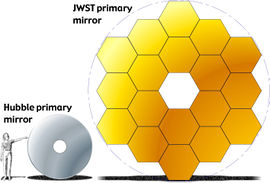
The JWST program is in the final design and fabrication phase (Phase C). As is typical for a complex design that cannot be changed once launched, there are detailed reviews of every portion of design, construction, and proposed operation.
In April 2006 the program was independently reviewed following a replanning phase begun in August 2005. The review concluded the program was technically sound, but that funding phasing at NASA needed to be changed. NASA has rephased its JWST budgets accordingly. The August 2005 replanning was necessitated by the cost growth revealed in Spring 2005.[12] The primary technical outcomes of the replanning are significant changes in the integration and test plans, a 22-month launch delay (from 2011 to 2013), and elimination of system level testing for observatory modes at wavelength shorter than 1.7 micrometers. Other major features of the observatory are unchanged following the replanning efforts.
As of the 2005 re-plan, the life-cycle cost of the project was estimated at about US$4.5 billion. This comprises approximately US$3.5 billion for design, development, launch and commissioning, and approximately US$1.0 billion for ten years of operations.[12] ESA is contributing about €300million, including the launch,[13] and the Canadian Space Agency about $39M Canadian.[14] As of May 2007[update] costs were still on target,[15] but by 2010 cost over-runs were impacting other programs, though JWST itself remains on schedule.[16]
In January 2007 nine of the ten technology development items in the program successfully passed a non-advocate review.[17] These technologies were deemed sufficiently mature to retire significant risks in the program. The remaining technology development item (the MIRI cryocooler) completed its technology maturation milestone in April 2007. This technology review represented the beginning step in the process that ultimately moved the program into its detailed design phase (Phase C).
In March 2008, the project successfully completed its Preliminary Design Review (PDR). In April 2008, the project passed the Non-Advocate Review. Other passed reviews include the Integrated Science Instrument Module review in March 2009, the Optical Telescope Element review completed in October 2009, and the Sunshield review completed in January 2010.
In April 2010, the telescope passed the overall Mission Critical Design Review (MCDR). Passing the MCDR signified the integrated observatory will meet all science and engineering requirements for its mission.[18] The MCDR encompassed all previous design reviews. The project schedule will undergo a review during the months following the MCDR. The spacecraft design, which passed a preliminary review in 2009, will continue toward final approval in 2011.
Construction and engineering

NASA's Goddard Space Flight Center in Greenbelt, Maryland is leading the management of the observatory project. The project scientist for the James Webb Space Telescope is John C. Mather. Northrop Grumman Aerospace Systems serves as the primary contractor for the development and integration of the observatory. They are responsible for developing and building the spacecraft element, which includes both the spacecraft bus and sunshield. Ball Aerospace has been subcontracted to develop and build the Optical Telescope Element (OTE). Goddard Space Flight Center is also responsible for providing the Integrated Science Instrument Module (ISIM).[11]
The ISIM contains four science instruments.[19] NIRCam (Near InfraRed Camera) is an infrared imager which will have a spectral coverage ranging from the edge of the visible (0.6 micrometers) through the Near Infrared (5 micrometers).[20] The NIRCam will also serve as the observatory's wavefront sensor, which is required for wavefront sensing and control activities. The NIRCam is being built by a team led by the University of Arizona, with Principal Investigator Marcia Rieke. The industrial partner is Lockheed-Martin's Advanced Technology Center located in Palo Alto, California.[21]
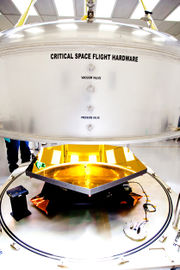
In addition to the Near Infrared (NIR) imaging capabilities of the NIRCam, the observatory will also perform spectrography over this range with the NIRSpec (Near InfraRed Spectrograph). NIRSpec is being built by the European Space Agency at ESTEC in Noordwijk, the Netherlands, leading a team involving EADS Astrium, Ottobrunn, and Friedrichshafen, Germany, and the Goddard Space Flight Center: the NIRSpec project scientist is Peter Jakobsen. The NIRSpec design provides 3 observing modes: a low resolution mode using a prism, an R~1000 multi-object mode and an R~2700 integral field unit or long-slit spectroscopy mode.[22] Switching of the modes is done by operating a wavelength preselection mechanism called Filter Wheel Assembly and selecting a correspondent dispersive element (prism or grating) using the Grating Wheel Assembly mechanism. Both mechanisms are based on the successful ISOPHOT wheel mechanisms of the Infrared Space Observatory. The mechanisms and their optical elements are being designed, integrated and tested by Carl Zeiss Optronics GmbH of Oberkochen, Germany, under contract from Astrium.
The mid-IR wavelength range will be measured by the MIRI (Mid InfraRed Instrument), which contains both a mid-IR camera and spectrometer that has a spectral range extending from 5 to 27 micrometers.[23] MIRI is being developed as a collaboration between NASA and a consortium of European countries, and is led by George Rieke (University of Arizona) and Gillian Wright (UK Astronomy Technology Centre, Edinburgh, part of the Science and Technology Facilities Council (STFC)).[21] MIRI features similar wheel mechanisms as NIRSpec which are also developed and built by Carl Zeiss Optronics GmbH under contract from the Max Planck Institute for Astronomy, Heidelberg.
The FGS (Fine Guidance Sensor), led by the Canadian Space Agency under project scientist John Hutchings (Herzberg Institute of Astrophysics, National Research Council of Canada), is used to stabilize the line-of-sight of the observatory during science observations and also includes a Tunable Filter module for astronomical narrow-band imaging in the 1.5 to 5 micrometer wavelength range.[21][24] The infrared detectors for both the NIRCam and NIRSpec modules are being provided by Teledyne Imaging Sensors (formerly Rockwell Scientific Company).
NASA is considering plans to add a grapple feature so future spacecraft might visit the observatory to fix gross deployment problems, such as a stuck solar panel or antenna. However, the telescope itself would not be serviceable, so that astronauts would not be able to perform tasks such as swapping instruments, as with the Hubble Telescope.[25][26][27][28] Final approval for such an addition was to be considered as part of the Preliminary Design Review in March 2008.
Most of the data processing on the telescope is done by conventional single board computers.[29] The conversion of the analog science data to digital form is performed by the custom-built SIDECAR ASIC (System for Image Digitization, Enhancement, Control And Retrieval Application Specific Integrated Circuit). It is said that the SIDECAR ASIC will include all the functions of a 20-pound instrument box in a package the size of a half-dollar, and consume only 11 milliwatts of power. Since this conversion must be done close to the detectors, on the cool side of the telescope, the low power use of this IC will be important for maintaining the low temperature required for optimal operation of the JWST.[30]
Ground support
The Space Telescope Science Institute (STScI) in Baltimore, Maryland has been selected as the Science and Operations Center (S&OC) for JWST. In this capacity, STScI will be responsible for the scientific operation of the telescope and delivery of data products to the astronomical community.[7]
Public displays
In May 2007 a full-scale model of the telescope was assembled for display at the Smithsonian's National Air and Space Museum on the National Mall, Washington DC. The model was intended to give the viewing public a better understanding of the size, scale and complexity of the satellite. The model is significantly different from the telescope, as the model must withstand gravity and weather, so is constructed mainly of aluminum and steel measuring approximately 24 m (79 ft) x 12 m (39 ft) x 12 m (39 ft) and weighs 5.5 tonnes (12,000 lb).
The model has been on display at various places since 2005: Seattle, Washington; Colorado Springs, Colorado; Paris, France; Greenbelt, Maryland; Rochester, New York; Orlando, Florida; Dublin, Ireland; Montreal, Canada; Hatfield, United Kingdom; Munich, Germany, and Manhattan, New York. The model was built by the main contractor, Northrop Grumman Aerospace Systems.[31]
Most recently, the model was on ongoing display in New York City's Battery Park during the 2010 World Science Festival. It served as the backdrop for a panel discussion featuring Nobel Prize laureate John C. Mather, astronaut John Grunsfeld and astronomer Heidi Hammel, which was followed by a star party hosted by Neil deGrasse Tyson, the director of the city's Hayden Planetarium.
See also
- Space observatory
- Great Observatories program
- Infrared astronomy
- IRAS, Infrared Space Observatory, Spitzer Space Telescope, and Herschel Space Observatory, all space-based infrared telescopes.
- Space Interferometry Mission
- Advanced Technology Large-Aperture Space Telescope
- New Worlds Mission
References
- ↑ "JWST Home Page". NASA. http://www.jwst.nasa.gov/. Retrieved 2010-03-011.
- ↑ spacenews.com
- ↑ "Frequently Asked Questions (FAQ) for Scientists". NASA. http://www.jwst.nasa.gov/faq_scientists.html#observations. Retrieved 9 August 2010.
- ↑ The Earth does not fully block the solar disc at the distance of the Earth-Sun L2, which is just outside of the Earth's umbra
- ↑ Maggie Masetti; Anita Krishnamurthi (2009). "JWST Science". NASA. http://www.jwst.nasa.gov/science.html. Retrieved 2009-05-02.
- ↑ Maggie Masetti; Anita Krishnamurthi (2009). "Why does JWST need to be at L2 publisher=NASA". http://www.jwst.nasa.gov/l2_moreinfo.html. Retrieved 2009-05-02.
- ↑ 7.0 7.1 Gardner, p. 588.
- ↑ http://www.nasa.gov/externalflash/webb_hubble/
- ↑ 9.0 9.1 9.2 9.3 "IR Astronomy: Overview". NASA Infrared Astronomy and Processing Center. http://www.ipac.caltech.edu/Outreach/Edu/importance.html. Retrieved 2006-10-30.
- ↑ http://www.nasa.gov/externalflash/webb_hubble/
- ↑ 11.0 11.1 Gardner, table XV, p. 597
- ↑ 12.0 12.1 John Mather. "James Webb Space Telescope (JWST)" (PDF). National Academy of Science. http://www7.nationalacademies.org/bpa/CAA_Nov2005_Presentation_Mather.pdf. Retrieved 2008-07-05.
- ↑ "European agreement on James Webb Space Telescope’s Mid-Infrared Instrument (MIRI) signed". Press release. 9 June 2004. http://www.esa.int/esaSC/Pr_10_2004_s_en.html. Retrieved 2009-05-06.
- ↑ "Canadian Space Agency: Canada's Contribution to NASA's James Webb Space Telescope.". Canadian Corporate News. http://findarticles.com/p/articles/mi_hb5559/is_/ai_n22557603. Retrieved 2008-09-06.
- ↑ Brian Berger. "NASA Adds Docking Capability For Next Space Observatory". Space News. http://www.space.com/businesstechnology/070523_techwed_jwst_dock.html. Retrieved 2008-07-05.
- ↑ Stephen Clark. "NASA says JWST cost crunch impeding new missions". Spaceflight Now. http://www.spaceflightnow.com/news/n1008/12jwst/.
- ↑ "JWST Passes NTAR". STScI. http://www.stsci.edu/jwst/project_highlights/tnar.html. Retrieved 2008-07-05.
- ↑ "NASA's Webb Telescope Passes Key Mission Design Review Milestone". NASA. http://www.nasa.gov/home/hqnews/2010/apr/HQ_10-099_Webb_Telescope_Milestone.html. Retrieved 2010-05-02.
- ↑ Gardner, p. 560.
- ↑ Gardner, p. 574.
- ↑ 21.0 21.1 21.2 "JWST Current Status". STScI. http://www.stsci.edu/jwst/overview/status.html. Retrieved 2008-07-05.
- ↑ Gardner, p. 578.
- ↑ Gardner, p. 580
- ↑ Gardner, p. 585
- ↑ Brian Berger (23 May 2007). "NASA Adds Docking Capability For Next Space Observatory". Space. http://www.space.com/businesstechnology/070523_techwed_jwst_dock.html. Retrieved 2009-05-02.
- ↑ Craig Covault (21 January 2008). "Moon Stuck: Space leaders work to replace lunar base with manned asteroid missions". Aviation Week & Space Technology: p. 24. http://spaceflightnow.com/news/n0801/18avweek/. Retrieved 2009-05-02.
- ↑ David Shiga (24 May 2007). "Hubble's successor could be fixed in space after all". NewScientist. http://space.newscientist.com/article/dn11925-hubbles-successor-could-be-fixed-in-space-after-all.html. Retrieved 2009-05-02.
- ↑ "Possibility of future space vehicle visits to JWST". NASA. http://www.nasa.gov/centers/goddard/news/topstory/2007/jwst_grapple.html. Retrieved 2009-05-02.
- ↑ "FBO DAILY ISSUE OF OCTOBER 30, 2002 FBO #0332". http://www.fbodaily.com/archive/2002/10-October/30-Oct-2002/FBO-00195113.htm.
- ↑ "Amazing Miniaturized 'SIDECAR' Drives Webb Telescope's Signal". NASA. 2008-02-20. http://www.nasa.gov/topics/universe/features/jwst_digital.html. Retrieved 2008-02-22.
- ↑ Webb Slinger Heads To Washington, accessed 8 May 2007
Further reading
- Jonathan P. Gardner; et al. (November 2006). "The James Webb Space Telescope". Space Science Reviews (Springer, Netherlands): 484–606. http://www.springerlink.com/content/q58315621w03/. The formal case for the JWST science, plus some implementation.
External links
- JWST homepage at NASA
- JWST homepage at STScI
- JWST homepage at ESA
- James Web Space Telescope Mission Profile by NASA's Solar System Exploration
- Cost overruns put squeeze on Hubble’s successor
- AIAA-2004-5986: JWST Observatory Architecture and Performance
- AIAA-2006-5593: Development of JWST's Ground Systems Using an Open Adaptable Architecture
Science instrument teams
|
||||||||||||||||||||||||||
|
|||||||||||||||||||||||||||||||||||||||||||
|
|||||||||||||||||||||||||||||||||||||||||||||||
|
|||||||||||
|
||||||||
